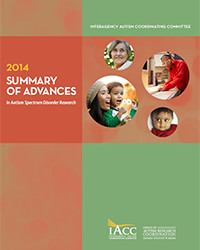Summary of Advances
In Autism Spectrum Disorder Research
2014
A longitudinal examination of 10-year change in vocational and educational activities for adults with autism spectrum disorders
Taylor JL, Mailick MR. Dev Psychol. 2014 Mar;50(3):699-708. [PMID: 24001150]
Relative to youth with other disabilities, when many young adults with ASD leave high school, they often receive fewer services and are less engaged in education and employment. However, it is not known whether these youth are experiencing a temporary or long-term setback. To address this gap, this study examined the vocational and educational activities of a sample of adults with ASD over a 10-year period. The researchers also looked at personal characteristics (such as intellectual disability, maladaptive behaviors, and daily living skills) and contextual resources (such as family income and parental social networks) that might impact levels of independence in employment and educational activities after high school. The current study drew on a subsample of 161 adults (ages 18–52) already enrolled in a larger longitudinal study of families with adolescent and adult children with ASD. The larger study collected data on families at six points over a 10-year period 1998–2010. Nearly three quarters of the adults with ASD in the current study were male, and about 80% had some level of ID. Most subjects (who were all 18 years or older) were living with a parent or other relative when the current study began. The researchers sought to determine whether the vocational and educational activities of these adults had become more independent, stayed the same, or had become less independent over a 10-year period. This study showed that independence in educational and employment activities had significant declines. Less than 25% of adults showed any improvement in vocational activities, and less than 5% had any improvements that were considered substantial. The results suggested that poor outcomes after high school are not a temporary setback, but stay the same and even worsen for some throughout adulthood. Women experienced particularly severe vocational declines, with a 15 times greater decline than the average male subject over the 10-year study period. While researchers determined that women’s worsening employment status over time was not associated with greater impairment, there are other factors that may have played a role such as gender stereotyping and parental expectations. The researchers predicted that contextual supports such as family income or receipt of various support services outside the family would improve the level of job independence of subjects over time; however, the effect of such support was only marginal.
Consistent with the researchers’ hypothesis, adults with ASD who had greater independence in their daily living activities were more independent in their vocational and educational activities. Though, researchers could not isolate if independence in daily living leads to more independence in vocational and educational activities, or if the effect is vice versa. These findings indicate a need for additional research on the challenges faced by adults with ASD after leaving high school, and especially on the worsening gender disparities in employment faced by adult females with ASD.




